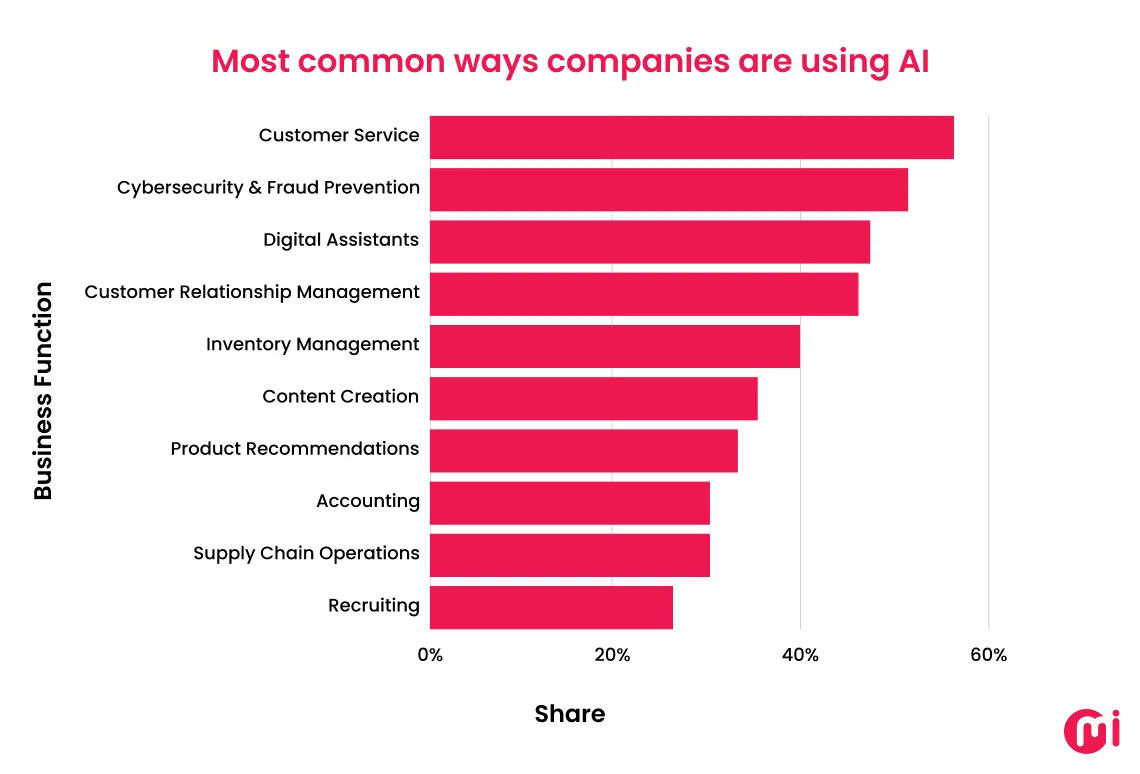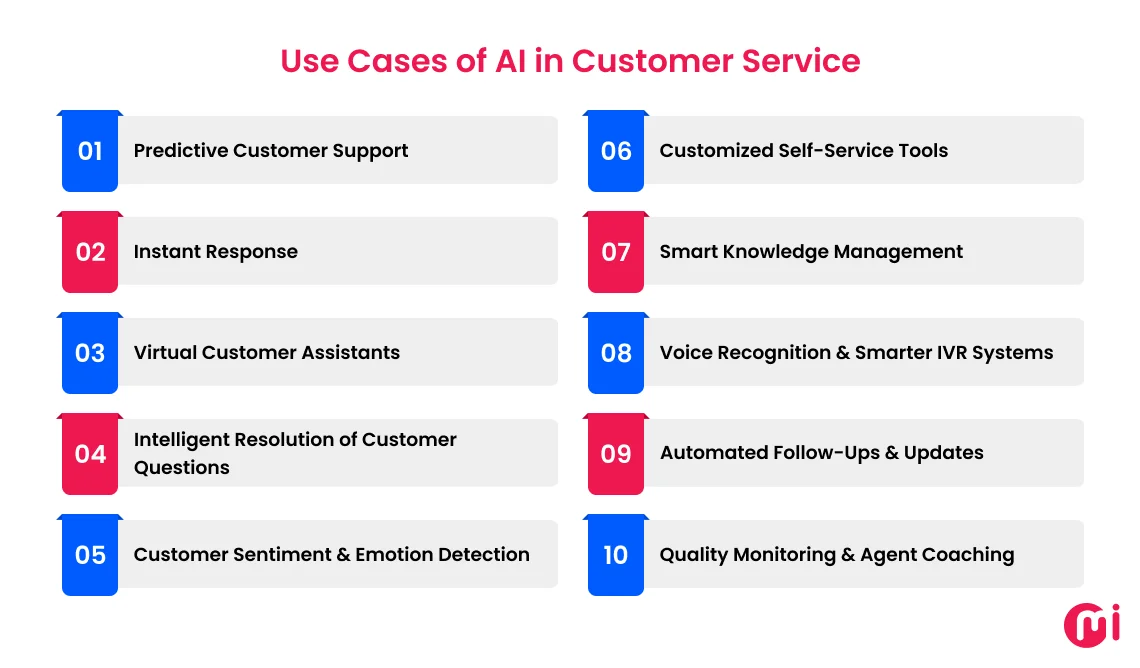With more than 50%, use cases of AI in customer service have the fairest share, which is more than cybersecurity and digital assistants. Artificial Intelligence (AI) is reshaping businesses’ interactions with customers, offering instant answers, smarter support systems, and predictive solutions.
From virtual assistants to personalized recommendations, AI-powered customer service improves efficiency, customer satisfaction, and scalability. Businesses using AI say it has improved their ability to scale customer service operations and the company’s growth. For example, Bradesco improved customer experience by 85%, and SquareDash increased accessibility by 99%.

The above-mentioned are just a glance; however, this blog explains AI customer service in detail. It includes use cases, benefits, real-life examples, and how to implement AI in customer service. Through this blog, you’ll have a clear understanding of AI-powered customer service before you hire AI developers to leverage its benefits.
Key Takeaways:
- AI in customer service boosts efficiency, personalization, and scalability while improving customer satisfaction.
- Traditional customer service struggles with speed and personalization, but AI delivers instant, tailored support.
- AI unlocks 24/7 support, efficiency, and personalization, giving your business the edge to scale customer experience.
- Real-world examples from companies like SquareDash and Bradesco, prove AI delivers measurable business impact.
- Successful AI adoption requires a clear strategy, quality data, and balanced automation with a human touch.
What is AI in Customer Service?
AI in customer service is about using artificial intelligence to automate, streamline, and enhance interactions between businesses and customers. It involves using various tools and applications to respond to customer inquiries around the clock.
Common AI applications in customer service include chatbots, virtual assistants, automated email responses, and sentiment analysis tools. These technologies employ machine learning algorithms and natural language processing (NLP) to gain understanding and respond to customer queries accurately and in real time.
AI-powered customer service helps businesses achieve faster response times with tailored customer interactions and resolve issues quickly.
Stats of the Uses of AI in Customer Services
AI has various use cases, like AI in supply chain management, AI for digital assistants, AI in inventory management, and more, however, customer service has topped the ranking. 56% of business owners use AI for customer service operations. See the image below to ensure an easy understanding:


The Role of AI in Customer Service
There’s a significant role of AI in customer service. It improves efficiency, leading to enhanced customer satisfaction. Since today’s customers expect real-time, tailored support and are less tolerant of disjointed or delayed experiences, AI becomes a must-have. AI-powered customer service enables faster responses, 24/7 support, personalized recommendations, and automated task handling.
By analyzing customer behavior and predicting their needs, artificial intelligence in customer service provides a strategic advantage, enhances the overall customer experience, and builds loyalty. It results in reduced costs and frees up human agents to handle complex issues, fostering a culture of efficient customer service with optimized profitability.
Use Cases of AI in Customer Service with Examples
There are many use cases of AI in customer service, including predictive customer support, instant response, virtual customer assistance, and many more. Here’s how they are transforming business across industries:


1. Predictive Customer Support
Artificial intelligence in customer service spots when something is not right, including the cases when there’s an unusual account activity or a service about to lapse. By predicting the potential issue, AI helps customers before they even realize it.
AI uses analytics like past interactions, purchase history, usage patterns, and even device logs to look at customers’ past behavior and compare it to real-time patterns. It helps figure out what you may need to do next, for example, a subscription renewal reminder or help with a product.
Example: A telecom company uses AI to detect unusual patterns in internet connectivity. Before the customer even notices the outage, the system automatically creates a support ticket, informs the user, and suggests appropriate fixes.
Impact: Reduced downtime, improved customer satisfaction, and fewer inbound complaints.
2. Instant Response
Remember the last time you asked a question on a website and got the answer right away. That’s usually a chatbot. AI-powered chatbots offer immediate answers and assistance to common customer queries and FAQs, regardless of time.
An AI chatbots development company builds chatbots using natural language processing (NLP) and machine learning (ML), enabling them to understand and respond to users’ queries in human language. The NLP enables chatbots to learn from historical customer interactions and improve over time.
Example: An eCommerce brand deploys an AI chatbot that instantly handles order status inquiries, returns, or refund requests. It helps the brand free up human agents for complex issues.
Impact: Faster resolution times, lower support costs, and better scalability during peak demand (like holiday sales).
3. Virtual Customer Assistants (VCAs)
Virtual customer assistants are more advanced compared to basic chatbots that handle multi-turn conversations and even complete transactions. VCAs are often used in e-commerce. They’re found in mobile apps or smart devices that make use of conversational AI, which combines NLP and ML, creating human-like interactions.
AI agents are capable of handling more complex tasks, such as placing orders, resolving account issues, or offering product advice, through both text and voice.
Example: A bank’s VCA helps customers open new accounts, apply for loans, or reset passwords without human involvement.
Impact: Reduced call center load, faster query resolution, and improved accessibility.
4. Intelligent Resolution of Customer Questions
AI customer service automatically assesses query type, sentiment, and urgency, then routes it to the best-suited agent. While machine learning analyzes historical behaviours and outcomes, predictive analytics makes use of data to forecast the urgency and immediately refer it to the right people.
Example: An insurance company’s AI system directs high-priority claims to senior adjusters while routine billing questions go to automated support.
Impact: Reduced wait times, higher first-call resolution, and better use of human expertise.
5. Customer Sentiment & Emotion Detection
AI-enabled tools in customer service can read the tone and emotion in a customer’s message. These tools use sentiment analysis technology and evaluate language cues, aiming to understand how someone feels.
AI monitors tone of voice, word choice, or chat inputs to detect frustration, satisfaction, or confusion in real time. It helps them know whether the customer is angry, frustrated, or happy, enabling teams to respond faster to unhappy customers and wisely handle tough conversations with appropriate care.
Example: A call center system flags when a customer sounds angry and alerts supervisors to intervene or offer escalation.
Impact: It results in proactive recovery of bad experiences and improved customer loyalty.
6. Customized Self-Service Tools
AI personalizes knowledge, base, articles, FAQs, and troubleshooting steps based on the customer’s profile and history. Instead of getting a customer digging through an endless loop of help pages or FAQs, AI-enabled customer services advise the exact solution.
These solutions are guides, videos, or solutions based on what a customer searched for, viewed, or purchased. The very system relies on recommendation engines, an algorithm engine, trained to recognize and advise relevant resources.
Example: A software development company offers AI-powered troubleshooting tailored to the user’s operating system and past product issues.
Impact: This results in higher self-service success rates and reduced support tickets, improving user experience and the brand’s credibility.
7. Smart Knowledge Management
AI in customer service scans, tags, and organizes a large amount of support content. It creates a wider knowledge base to support both support agents and customers, finding the right answers in no time.
AI uses machine learning to learn and determine the most relevant article based on the customer’s query. There are some companies that use generative AI, enabling them to instantly create tailored help content or summaries.
Example: An airline company uses AI to automatically add new flight change policies into its support documentation after updates.
Impact: Always up-to-date resources and faster agent onboarding. It fosters faster updates, fewer errors, consistent information across all touchpoints, and less burden on human support teams.
8. Voice Recognition and Smarter IVR Systems
AI-enabled voice recognition enables automated phone systems, like IVR (Interactive Voice Response), to understand spoken language. Instead of getting forced through endless “press 1, press 2” cycles, IVR systems enable users to explain their issue naturally.
Perfectly combined with conversational AI, the system fosters an intuitive, less frustrating phone assistance experience, boosting the support center’s efficiency and credibility.
Example: